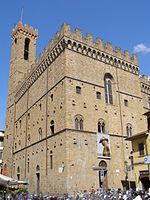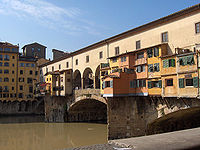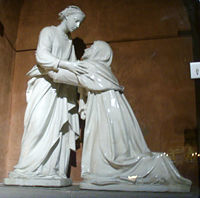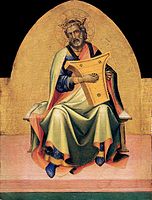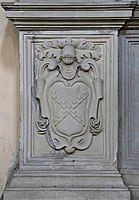This article needs additional citations for
verification. (November 2017) |

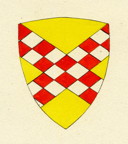
The Fioravanti family was a noble family originating in Pistoia in Tuscany and active in Florence and other Italian towns. They were Guelf in their politics and naturally allied with the Cancellieri family and adversaries of the Ghibelline Panciatichi Panciatichi family. An early record dates to 1267, when Fioravanti d'Accorso was a member of the town council. In 1310 Ranieri, his son, was Mayor of the Pistoia. In 1319 Simone di Ranieri was a member of the elders. Giovanni di Puccio di Ranieri Fioravanti was a banker active at the court of Pope Clement V (1305-1314) in Avignon. Andrea di Simone di Baldo Fioravanti was elected Capitano della Montagna Superiore, June 17, 1354. Francesco di Rinieri was the Gonfaloniere of the Florentine Republic in the years 1385 and 1389: Neri his son was also Gonfaloniere in 1428; Fioravanti di Piero was the Cavalry Captain in Flanders in 1510 and then for Pope Alessandro VI, commissioner at Assedius of Faenza: Vincenzo di Cipriano one of the first to be elected knight of Santo Stefano, in 1576, shortly after the establishment of that military order, and later Chancellor of the Order: Fabio of Cipriano, was Cavalry Captain in the Netherlands: Alberto di Fioravanti Knight of Malta in 1590, and Commendatore in 1610: Niccolao di Fioravanti captain in the emperor Ferdinand II against the King of Sweden in 1636, and in 1643 in Tuscany for the Grand Duke against the Barberini. [1]
Since the 13th century, the Fioravanti were dedicated to large international trading ventures. In England they bought the wool which they then resold in the most important European centers in the form of pieces of cloth, woven in their Florentine workshops. From the East, through the Venetian market, they imported spices which they then resold in Florence and Naples. Occasionally they bought whole loads of grain and then also became shipowners. Instead of hiring one or more ships for transport, they bought the necessary ships and then resold goods and ships in the port of destination. They did not disdain to participate in some big business
The Fioravanti were active in banking, especially associating with the Acciaioli, a family with which they had an uninterrupted relationship of interests and kinship. Once the financial power had stabilized, they extended their influence into the political field, and towards the middle of the fourteenth century they began to participate actively in the Florentine republican government, especially during the Florentine oligarchy headed by the Albizzi, prior to the rise of Cosimo de'Medici .
Neri di Fioravanti or Fieravante was the first to hold public office in Florence, elected among the priors in 1344, he subsequently obtained the same office four more times,1353, 1358, 1362 and 1366. From 1340 until December 1345, he was responsible for the expansion and restructuring of the Palazzo del Podestà, the Bargello, the most important Florentine project in those years in the field of civil architecture. His son Francesco found the ideal ground already prepared for a personal affirmation and for determining a further social ascent of the family: he soon became one of the most important citizens of his time. In particular he took care of the construction of the great hall of the council, with its imposing vaulted ceiling, as well as the open staircase in the courtyard with a three-mullioned window towards Piazza S. Firenze which made the building lose its appearance of a fortress. On 19 May 1350 the Castella office prepared written instructions for the orthogonal, symmetrical and centralized plan of the new city of Giglio Fiorentino, of which Fioravanti is in all probability the author. On 9 Feb. 1350 F. received together with Benci di Cione, who worked with him at the Bargello, a monthly payment as master builder of the church of S. Anna dei Lombardi, now the church of S. Carlo Borromeo, opposite Orsanmichele in Florence. In 1350 Fioravanti was responsible for the construction of the Falconieri chapel, located to the right of the transept in the church of Ss. Annunziata. On May 29, 1363,is documented at the service of the Falconieri, the major clients of the Ss. Annunziata in the fourteenth century, with the task of protecting their interests in the evaluation of the land to buy for the construction of the cathedral. On 5th Jan. 1351 Fioravanti is active for the first time in the construction of the Florence cathedral. Together with three other masters, including Alberto di Amoldo, he received the first of many commissions relating to the marble cladding and the pietraforte for the bell tower. The stonemasons were in fact responsible for the purchase of the stone, mostly coming from quarries located near Florence, for its processing according to the instructions of the master builder Francesco Talenti, for its shipment to the construction site and for its installation. F. and the others continued to procure cut stones until 6 February. 1357 (Guasti, 1887; Trachtenberg, 1971). In the group, F. maintained a position of prominence; he was responsible for the safety of others and the clients referred to him. Critics have linked his name to the reliefs of the Virtues and to the statues on the south side of the bell tower, but there are no documents in this regard (Venturi, 1906, pp. 680, 683). From 1355 the Opera del Duomo asked for the opinion of the F. regarding both the project and the construction. He advised Francesco Talenti for the nave of the cathedral (July 16, 1355), for his design for the fretwork of the three-light windows of the bell tower (Aug. 13, 1356), for the stucco models of the nave pillars (June 15, July 17, 3 Aug. 1357), for the measurement of the vaults of the nave and the church (June 19, 1357) and for the external cladding of the sides of the church (a list of 29 arguments was presented on Jan. 4, 1358).
During the same period he was asked to examine the problems relating to the capstan of the bell tower and the iron reinforcement of the bell tower (May 11, 1357), the foundations of the pillars of the nave of the church (June 19, 1357), and the cost of the foundations.
Francesco Fioravanti, the son of Neri between 1374 and 1398 was elected a Prior and two Gonfalone, but his weight in the republican government was by far more decisive than what the three magistracies suggest. In practice, as Scipione Ammirato says, Francesco di Neri, at the end of the fourteenth century "had the management of the entire Florentine Republic". He was ambassador to Siena in 1395 and to the pope in 1396 and 1399. In Francesco's time the Fioravanti reached the peak of their fortune, also thanks to the contribution of Bartolommeo, less known but very efficient, Francesco's brother, wholly dedicated to lucrative commercial dealings. [2]
-
The Florentine version of the Fioravanti arms in the town of Reggello.
-
The Pistoian version of the Fioravanti arms.
-
Dome Santa Maria del Fiore. Neri Fioravanti
-
The Bargello. Neri Fioravanti
-
The Ponte Vecchio Neri Fioravanti
-
Palazzo Fioravanti in Florence in a late Mannerist style is generally attributed to Bartolomeo Ammannati and by others to Bernardo Buontalenti.
-
Luca della Robbia "Visitation", was commissioned by the Fioravanti family of Pistoia for the church of San Giovanni Fuoricivitas, the church faces the Palazzo Fioravanti.
-
San Pier Maggiore, Florence. Demolished in the 18th century contained the Fioravanti chapel painted by Lorenzo Monaco.
-
King David by Lorenzo Monaco circa 1408–1410. Some scholars believe this panel was part of the Fioravanti chapel in San Pier Maggiore in Florence. Metropolitan Museum of Art. New York.
-
The Fioravanti arms in the church of San Domenico, Pistoia.
-
The arms of Jacopo Fioravanti c. 1570 in the Palazzo della Carovana, the headquarters of the Knights of St. Stephen, Pisa.
-
Oratory of St. Anthony the Abbot, Pistoia. Founded by Puccio Fioravanti in 1333 for use by the church San Giovanni Fuorcivitas, on the left.
References
- ^ "HomePage". www.archiviopistoia.it. Archived from the original on 2018-11-18. Retrieved 2017-11-04.
- ^ Le Famiglie di Firenze, Roberto Ciabani Vol 2 pg. 329
This article needs additional citations for
verification. (November 2017) |


The Fioravanti family was a noble family originating in Pistoia in Tuscany and active in Florence and other Italian towns. They were Guelf in their politics and naturally allied with the Cancellieri family and adversaries of the Ghibelline Panciatichi Panciatichi family. An early record dates to 1267, when Fioravanti d'Accorso was a member of the town council. In 1310 Ranieri, his son, was Mayor of the Pistoia. In 1319 Simone di Ranieri was a member of the elders. Giovanni di Puccio di Ranieri Fioravanti was a banker active at the court of Pope Clement V (1305-1314) in Avignon. Andrea di Simone di Baldo Fioravanti was elected Capitano della Montagna Superiore, June 17, 1354. Francesco di Rinieri was the Gonfaloniere of the Florentine Republic in the years 1385 and 1389: Neri his son was also Gonfaloniere in 1428; Fioravanti di Piero was the Cavalry Captain in Flanders in 1510 and then for Pope Alessandro VI, commissioner at Assedius of Faenza: Vincenzo di Cipriano one of the first to be elected knight of Santo Stefano, in 1576, shortly after the establishment of that military order, and later Chancellor of the Order: Fabio of Cipriano, was Cavalry Captain in the Netherlands: Alberto di Fioravanti Knight of Malta in 1590, and Commendatore in 1610: Niccolao di Fioravanti captain in the emperor Ferdinand II against the King of Sweden in 1636, and in 1643 in Tuscany for the Grand Duke against the Barberini. [1]
Since the 13th century, the Fioravanti were dedicated to large international trading ventures. In England they bought the wool which they then resold in the most important European centers in the form of pieces of cloth, woven in their Florentine workshops. From the East, through the Venetian market, they imported spices which they then resold in Florence and Naples. Occasionally they bought whole loads of grain and then also became shipowners. Instead of hiring one or more ships for transport, they bought the necessary ships and then resold goods and ships in the port of destination. They did not disdain to participate in some big business
The Fioravanti were active in banking, especially associating with the Acciaioli, a family with which they had an uninterrupted relationship of interests and kinship. Once the financial power had stabilized, they extended their influence into the political field, and towards the middle of the fourteenth century they began to participate actively in the Florentine republican government, especially during the Florentine oligarchy headed by the Albizzi, prior to the rise of Cosimo de'Medici .
Neri di Fioravanti or Fieravante was the first to hold public office in Florence, elected among the priors in 1344, he subsequently obtained the same office four more times,1353, 1358, 1362 and 1366. From 1340 until December 1345, he was responsible for the expansion and restructuring of the Palazzo del Podestà, the Bargello, the most important Florentine project in those years in the field of civil architecture. His son Francesco found the ideal ground already prepared for a personal affirmation and for determining a further social ascent of the family: he soon became one of the most important citizens of his time. In particular he took care of the construction of the great hall of the council, with its imposing vaulted ceiling, as well as the open staircase in the courtyard with a three-mullioned window towards Piazza S. Firenze which made the building lose its appearance of a fortress. On 19 May 1350 the Castella office prepared written instructions for the orthogonal, symmetrical and centralized plan of the new city of Giglio Fiorentino, of which Fioravanti is in all probability the author. On 9 Feb. 1350 F. received together with Benci di Cione, who worked with him at the Bargello, a monthly payment as master builder of the church of S. Anna dei Lombardi, now the church of S. Carlo Borromeo, opposite Orsanmichele in Florence. In 1350 Fioravanti was responsible for the construction of the Falconieri chapel, located to the right of the transept in the church of Ss. Annunziata. On May 29, 1363,is documented at the service of the Falconieri, the major clients of the Ss. Annunziata in the fourteenth century, with the task of protecting their interests in the evaluation of the land to buy for the construction of the cathedral. On 5th Jan. 1351 Fioravanti is active for the first time in the construction of the Florence cathedral. Together with three other masters, including Alberto di Amoldo, he received the first of many commissions relating to the marble cladding and the pietraforte for the bell tower. The stonemasons were in fact responsible for the purchase of the stone, mostly coming from quarries located near Florence, for its processing according to the instructions of the master builder Francesco Talenti, for its shipment to the construction site and for its installation. F. and the others continued to procure cut stones until 6 February. 1357 (Guasti, 1887; Trachtenberg, 1971). In the group, F. maintained a position of prominence; he was responsible for the safety of others and the clients referred to him. Critics have linked his name to the reliefs of the Virtues and to the statues on the south side of the bell tower, but there are no documents in this regard (Venturi, 1906, pp. 680, 683). From 1355 the Opera del Duomo asked for the opinion of the F. regarding both the project and the construction. He advised Francesco Talenti for the nave of the cathedral (July 16, 1355), for his design for the fretwork of the three-light windows of the bell tower (Aug. 13, 1356), for the stucco models of the nave pillars (June 15, July 17, 3 Aug. 1357), for the measurement of the vaults of the nave and the church (June 19, 1357) and for the external cladding of the sides of the church (a list of 29 arguments was presented on Jan. 4, 1358).
During the same period he was asked to examine the problems relating to the capstan of the bell tower and the iron reinforcement of the bell tower (May 11, 1357), the foundations of the pillars of the nave of the church (June 19, 1357), and the cost of the foundations.
Francesco Fioravanti, the son of Neri between 1374 and 1398 was elected a Prior and two Gonfalone, but his weight in the republican government was by far more decisive than what the three magistracies suggest. In practice, as Scipione Ammirato says, Francesco di Neri, at the end of the fourteenth century "had the management of the entire Florentine Republic". He was ambassador to Siena in 1395 and to the pope in 1396 and 1399. In Francesco's time the Fioravanti reached the peak of their fortune, also thanks to the contribution of Bartolommeo, less known but very efficient, Francesco's brother, wholly dedicated to lucrative commercial dealings. [2]
-
The Florentine version of the Fioravanti arms in the town of Reggello.
-
The Pistoian version of the Fioravanti arms.
-
Dome Santa Maria del Fiore. Neri Fioravanti
-
The Bargello. Neri Fioravanti
-
The Ponte Vecchio Neri Fioravanti
-
Palazzo Fioravanti in Florence in a late Mannerist style is generally attributed to Bartolomeo Ammannati and by others to Bernardo Buontalenti.
-
Luca della Robbia "Visitation", was commissioned by the Fioravanti family of Pistoia for the church of San Giovanni Fuoricivitas, the church faces the Palazzo Fioravanti.
-
San Pier Maggiore, Florence. Demolished in the 18th century contained the Fioravanti chapel painted by Lorenzo Monaco.
-
King David by Lorenzo Monaco circa 1408–1410. Some scholars believe this panel was part of the Fioravanti chapel in San Pier Maggiore in Florence. Metropolitan Museum of Art. New York.
-
The Fioravanti arms in the church of San Domenico, Pistoia.
-
The arms of Jacopo Fioravanti c. 1570 in the Palazzo della Carovana, the headquarters of the Knights of St. Stephen, Pisa.
-
Oratory of St. Anthony the Abbot, Pistoia. Founded by Puccio Fioravanti in 1333 for use by the church San Giovanni Fuorcivitas, on the left.
References
- ^ "HomePage". www.archiviopistoia.it. Archived from the original on 2018-11-18. Retrieved 2017-11-04.
- ^ Le Famiglie di Firenze, Roberto Ciabani Vol 2 pg. 329


